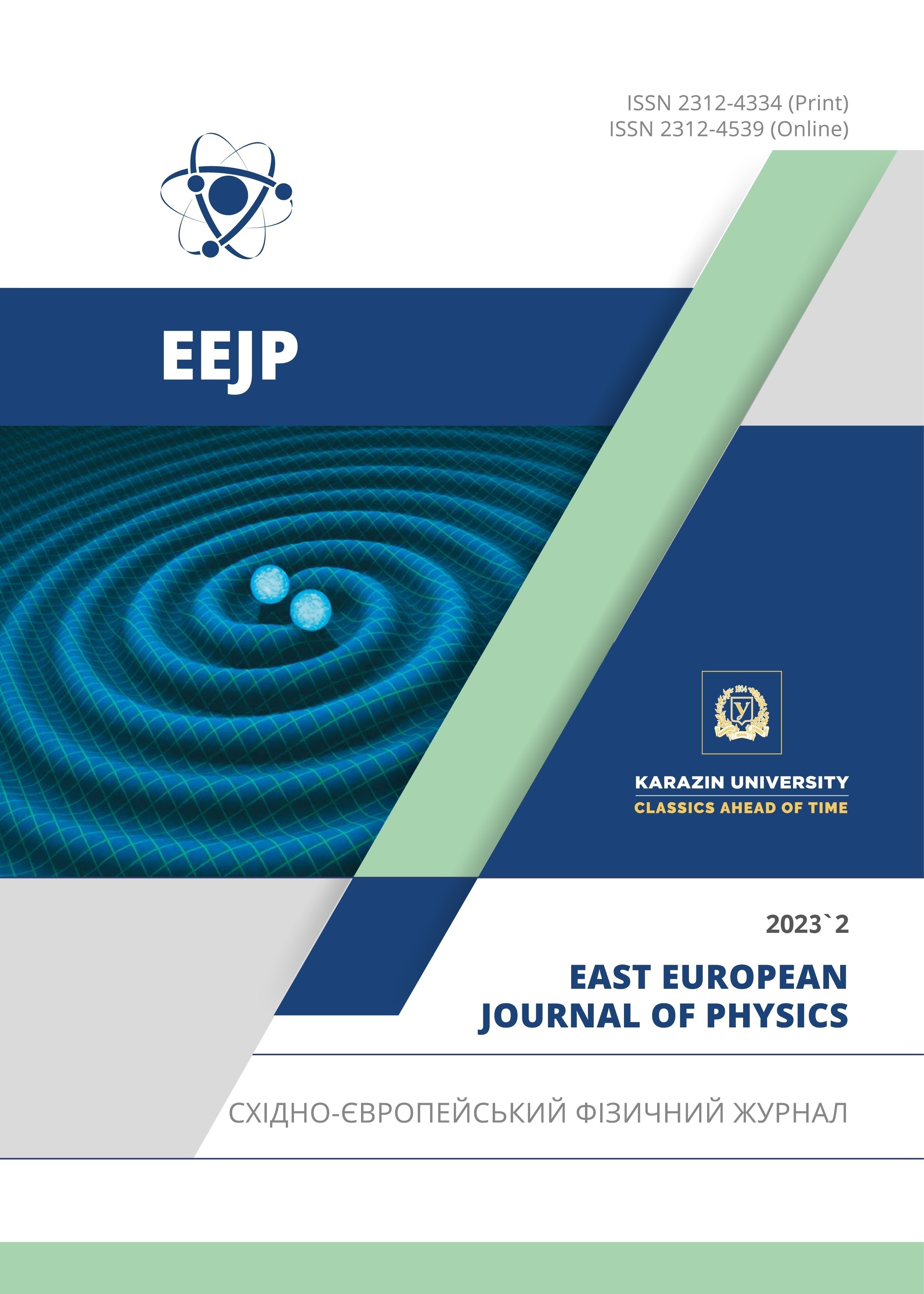The Effect of Diffuseness Parameter on the Quasi-Elastic Scattering of the 25Mg + 90Zr and 28Si + (120Sn ,150Nd) Systems using Wood-Saxon Potential
Abstract
In this research, the effect of changing the values of the diffusion parameter on the semi-elastic scattering ( ) and distribution (D) calculations for (SC) and (CC) have been studied. Three values were taken from the diffusion for each system parameter. It is assumed that the nuclear potential has a Woods-Saxon form, which is indicated by the surface diffuseness, potential depth, and radius parameters for (25Mg + 90Zr), (28Si + (120Sn ,150Nd) Systems. The chi-square (χ2) is applied to compare the best-fitted value of the diffuseness parameter between the theoretical calculations and the experimental data. According to the results of (χ2 ), we noticed that some systems achieved a good match between the theoretical calculations and experimental data of semi-elastic scattering ( ) and the distribution calculations at the standard value of the diffusion parameter (a0=0.63 ) or at a value higher and lower than the standard value. In the case of (SC ) the best fit was at a value less than the standard value of the diffusivity parameter but in the case of (CC ), the fit was better at a value higher than the standard value of the diffusivity parameter because the potential barrier in the (SC ) is single, while in (CC ) calculations it is multiple.
Downloads
References
M. Dasgupta, D.J. Hinde, N. Rowley, and A. M. Stefanini, “Measuring Barriers To Fusion,” Annual Review of Nuclear and Particle Science, 48, 401-461 (1998). https://doi.org/10.1146/annurev.nucl.48.1.401
V.Y. Denisov, “Superheavy element production, nucleus‐nucleus potential and μ‐catalysis,” in AIP Conference Proceedings, 704(1), 92-101 (2004). https://doi.org/10.1063/1.1737100
L.R. Gasques, M. Evers, D.J. Hinde, M. Dasgupta, P.R.S. Gomes, R.M. Anjos, M.L. Brown, et al., “Systematic study of the nuclear potential through high precision back-angle quasi-elastic scattering measurements,” Phys. Rev. C - Nucl. Phys. 76(2), 024612 (2007). https://doi.org/10.1103/PhysRevC.76.024612
K. Hagino, and N. Rowley, “Large-angle scattering and quasielastic barrier distributions,” Phys. Rev. C, 69(5), 054610 (2004). https://doi.org/10.1103/PhysRevC.69.054610
M. Zamrun, K. Hagino, S. Mitsuoka, and H. Ikezoe, “Coupled-channels analyses for large-angle quasi-elastic scattering in massive systems,” Phys. Rev. C, 77(3), 034604 (2008). https://doi.org/10.1103/PhysRevC.77.034604
A.B. Balantekin, and N. Takigawa “Quantum Tunneling in Nuclear Fusion,” Rev. Mod. Phys. 70, 77 (1998). https://doi.org/10.1103/RevModPhys.70.77
K. Hagino, N. Rowley, and A.T. Kruppa, “A program for coupled-channel calculations with all order couplings for heavy-ion fusion reactions,” Comput. Phys. Commun. 123(1-3), 143-152 (1999). https://doi.org/10.1016/S0010-4655(99)00243-X
K. Washiyama, K. Hagino, and M. Dasgupta, “Probing surface diffuseness of nucleus-nucleus potential with quasielastic scattering at deep sub-barrier energies,” Phys. Rev. C, 73, 034607 (2006). https://doi.org/10.1103/PhysRevC.73.034607
K. Hagino, and K. Washiyama, “Probing internucleus potential with large-angle quasi-elastic scattering,” AIP Conference Proceedings, 853, 86-93 (2006). https://doi.org/10.1063/1.2338360
Q.J. Tarbool, K.S. Jassim, and A.A. Abojassim, “Surface diffuseness parameter with quasi-elastic scattering for some heavy-ion systems,” Int. J. Nucl. Energy Sci. Technol. 13(2), 110-119 (2019). https://www.inderscience.com/info/inarticle.php?artid=100758
N.H. Hayef, and K.S. Jassim, “Coupled channels for quasi-elastic scattering of determining diffuseness parameters in Woods-Saxon potential for nuclear reaction,” AIP Conference Proceedings, 2414(1), 030012 (2023). https://doi.org/10.1063/5.0117002
A.J. Hassan, and K.S. Jassim, “Effect of Surface Diffuseness Parameter on Quasi-elastic Scattering Calculations for 6He+64Zn, 7Li+64Zn and 8Li+90Zr Systems,” NeuroQuantology, 18(9), 40-44 (2020). https://doi.org/10.14704/nq.2020.18.9.NQ20214
R.D. Woods, and D.S. Saxon, “Diffuse surface optical model for nucleon-nuclei scattering,” Phys. Rev. 95(2), 577 (1954). https://doi.org/10.1103/PhysRev.95.577
P. Fröbrich, and R. Lipperheide, Theory of nuclear reactions, Vol. 18, 1st ed. (Clarendon Press, Oxford Studies, 1996). pp. 18.
M. Dasgupta, D.J. Hinde, J.O. Newton, and K. Hagino, “The nuclear potential in heavy-ion fusion,” Prog. Theor. Phys. Suppl. 154, 209-216 (2004). https://doi.org/10.1143/PTPS.154.209
R.A. Broglia, and A. Winther, Heavy Ion Reactions: Elastic and inelastic reactions, (Advanced B. Cummings Publishing Company, 1981).
Y.K. Gupta, B.K. Nayak, U. Garg, K. Hagino, K.B. Howard, N. Sensharma, M. Şenyiğit, et al., “Determination of hexadecapole (β4) deformation of the light-mass nucleus 24Mg using quasi-elastic scattering measurements,” Phys. Lett. Sect. B Nucl. Elem. Part. High-Energy Phys. 806, 135473 (2020). https://doi.org/10.1016/j.physletb.2020.135473
M. Sharma, A. Rani, S. Manda, S. Nath, N. Madhavan, J. Gehlot, Gonika, et al., “Quasi-Elastic Scattering Measurements for 28Si+116,120,124Sn Systems near Coulomb Barrier,” Proceedings of the DAE Symp. on Nucl. Phys. 65, 433-434 (2021). https://inspirehep.net/files/f1ec2021066b5c813665ad770c13244c
S. Biswas, A. Chakraborty, A. Jhingan, D. Arora, B.R. Behera, R. Biswas, N.K. Deb, et al., “Barrier distribution for the 28Si+150Nd system through quasi-elastic excitation function measurement,” DAE Symp. Nucl. Phys. 64, 439 440 (2019). https://inspirehep.net/literature/1803955
Copyright (c) 2023 Farah J. Hamood, Khalid S. Jassim

This work is licensed under a Creative Commons Attribution 4.0 International License.
Authors who publish with this journal agree to the following terms:
- Authors retain copyright and grant the journal right of first publication with the work simultaneously licensed under a Creative Commons Attribution License that allows others to share the work with an acknowledgment of the work's authorship and initial publication in this journal.
- Authors are able to enter into separate, additional contractual arrangements for the non-exclusive distribution of the journal's published version of the work (e.g., post it to an institutional repository or publish it in a book), with an acknowledgment of its initial publication in this journal.
- Authors are permitted and encouraged to post their work online (e.g., in institutional repositories or on their website) prior to and during the submission process, as it can lead to productive exchanges, as well as earlier and greater citation of published work (See The Effect of Open Access).








